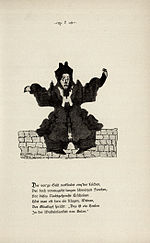83:
20:
69:
Spots of ink are dropped onto a piece of paper and the paper is folded in half, so that the ink will smudge and form a mirror reflection in the two halves. The piece of paper is then unfolded so that the ink can dry, after which someone can guess the resemblance of the print to other objects. The
98:
Justinus Kerner invented this technique when he started accidentally dropping blots of ink onto paper due to failing eyesight. Instead of throwing them away, he found that intriguing shapes appeared if he unfolded the papers. He elaborated these shapes into intricate cartoons and used them to
159:, Rorschach was reminded of his youthful inkblot hobby. He then created his Rorschach test to see if people's reactions to inkblots could be used as a tool to uncover unconscious desires. The test is essentially a visual variation on Freud's verbal technique.
131:
first suggested that inkblots might be used in psychological research, arguing that the interpretation of inkblots could be used to study variations in ‘involuntary imagination’.
143:
enjoyed klecksography so much that his friends nicknamed him "Klecks", meaning "inkblot". As a medical student, Rorschach studied under psychiatrist
293:
256:
219:
106:
In 1896, a similar game was described in the United States by Ruth McEnery Stuart and Albert
Bigelow Paine in a book titled
351:
110:. The book explained how to make inkblot monsters ("gobolinks") and use them as prompts for writing imaginative verse.
58:
168:
346:
173:
316:
289:
252:
246:
215:
209:
140:
54:
283:
99:
illustrate his poems. Kerner began a collection of klecksographs and poetry in 1857 titled
156:
87:
82:
46:
39:
24:
340:
285:
I Is an Other: The Secret Life of
Metaphor and How it Shapes the Way We See the World
152:
144:
19:
183:
128:
124:
50:
178:
148:
71:
35:
49:, who included klecksographs in his books of poetry. Since the 1890s,
53:
have used it as a tool for studying the subconscious, most famously
248:
Howard Andrew Knox: Pioneer of
Intelligence Testing at Ellis Island
81:
18:
211:
The Name's
Familiar: Mr. Leotard, Barbie, and Chef Boy-Ar-Dee
240:
238:
74:, the human tendency to see patterns in nature.
108:Gobolinks, or Shadow-Pictures for Young and Old
8:
251:. Columbia University Press. pp. 134–.
103:(and reproduced in several later editions).
70:inkblots tend to resemble images because of
277:
275:
203:
201:
199:
195:
214:. Pelican Publishing. pp. 232–.
7:
14:
34:is the art of making images from
288:. HarperCollins. pp. 63–.
282:James Geary (8 February 2011).
245:John T. E. Richardson (2011).
86:A page of poetry and art from
1:
45:). The work was pioneered by
139:As a child in Switzerland,
368:
95:
59:Rorschach inkblot test
28:
321:. 1897. pp. 143–
169:Holtzman Inkblot Test
85:
22:
352:Artistic techniques
208:Laura Lee (1999).
174:Active imagination
127:and his associate
123:As early as 1895,
96:
29:
23:A klecksograph by
295:978-0-06-204177-7
258:978-0-231-51211-4
221:978-1-4556-0918-5
147:, who had taught
141:Hermann Rorschach
114:Use in psychology
55:Hermann Rorschach
359:
331:
330:
328:
326:
313:
307:
306:
304:
302:
279:
270:
269:
267:
265:
242:
233:
232:
230:
228:
205:
27:, published 1879
367:
366:
362:
361:
360:
358:
357:
356:
337:
336:
335:
334:
324:
322:
315:
314:
310:
300:
298:
296:
281:
280:
273:
263:
261:
259:
244:
243:
236:
226:
224:
222:
207:
206:
197:
192:
165:
157:dream symbolism
137:
121:
119:Binet and Henri
116:
101:Klecksographien
92:Klecksographien
88:Justinus Kerner
80:
67:
47:Justinus Kerner
25:Justinus Kerner
17:
12:
11:
5:
365:
363:
355:
354:
349:
339:
338:
333:
332:
308:
294:
271:
257:
234:
220:
194:
193:
191:
188:
187:
186:
181:
176:
171:
164:
161:
151:. In studying
136:
133:
120:
117:
115:
112:
79:
76:
66:
63:
15:
13:
10:
9:
6:
4:
3:
2:
364:
353:
350:
348:
345:
344:
342:
320:
319:
312:
309:
297:
291:
287:
286:
278:
276:
272:
260:
254:
250:
249:
241:
239:
235:
223:
217:
213:
212:
204:
202:
200:
196:
189:
185:
182:
180:
177:
175:
172:
170:
167:
166:
162:
160:
158:
154:
150:
146:
145:Eugen Bleuler
142:
134:
132:
130:
126:
118:
113:
111:
109:
104:
102:
93:
89:
84:
77:
75:
73:
64:
62:
60:
56:
52:
51:psychologists
48:
44:
43:Tinten-Klecks
41:
37:
33:
32:Klecksography
26:
21:
323:. Retrieved
317:
311:
299:. Retrieved
284:
262:. Retrieved
247:
225:. Retrieved
210:
184:Talking cure
138:
129:Victor Henri
125:Alfred Binet
122:
107:
105:
100:
97:
91:
68:
42:
31:
30:
16:Inkblot art
341:Categories
190:References
179:Pareidolia
347:Paper art
318:Book News
149:Carl Jung
135:Rorschach
72:apophenia
163:See also
155:work on
36:inkblots
325:26 June
301:26 June
264:26 June
227:26 June
153:Freud's
78:History
57:in his
292:
255:
218:
94:(1890)
65:Method
40:German
327:2013
303:2013
290:ISBN
266:2013
253:ISBN
229:2013
216:ISBN
90:'s
343::
274:^
237:^
198:^
61:.
329:.
305:.
268:.
231:.
38:(
Text is available under the Creative Commons Attribution-ShareAlike License. Additional terms may apply.

